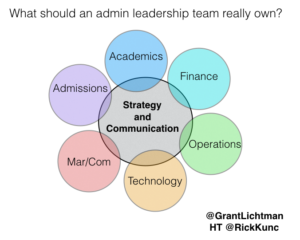Last week I posted Part 1 of the evolving role of a school or district admin leadership team. I want to dig deeper into this: How might we really amplify the power of this team of leaders?
Think about your admin leadership team and your team meetings. Like any group within an organization, your admin leadership team will function best when you have a shared purpose, a set of goals, a roadmap to achieve those goals, activities that will actually produce the desired results, and a set of team norms that will help you perform.
Can you answer these questions with respect to your admin leadership team?:
- What are the main goals of this team?
- What do we spend our meetings doing?
- Who “owns” these meetings? Is it always the highest title in the room?
- What does this team do/accomplish in between regular meetings?
- What is this team well positioned to do that no other team at the school can do?
As I posted yesterday, (HT Rick Kunc and Marc Ayotte), traditional admin teams have been a key locus of cross-silo communication. This is an uber-critical role in schools, that are as silo-ized as any organization on the planet. But the other critical role is to provide the glue between the schools strategic design and the all-school systems that will produce those strategic results. For example, if a school decides that differentiated or personalized learning will be a key element of their strategic value proposition, then they have to create and coordinate changes to things like curriculum, student assessments, and professional development that cross boundaries of class, department, grade level, or division.

The admin leadership team is the only entity that has the knowledge, position, and authority to design and implement these operating system-level changes. The board can’t; they are not professional educators. The principal or head of school or superintendent can’t; these are not CEO-level jobs. (The CEO can and should be part of this team.) The faculty or faculty senate-like teams can’t: these issues almost always have ramifications and impacts beyond just the academic side of the school.
So what SHOULD be the role of the admin leadership team? As this diagram tries to show, in addition to creating an effective communication pathway across silos, each member of the team brings issues that are related to truly strategic goals. They don’t need to share everything that is being done in their respective area; just what needs the attention of others to achieve strategic goals. Then the team needs to own and act on building that glue between what the school has promised to do (strategic design) and what it actually delivers to its stakeholders (value).
How can you enhance the effectiveness of the admin leadership team?
- Ask members to describe why “I” am here and why “we” are here.
- Brainstorm, synthesize, and summarize team goals.
- Define and filter the actual activities that the team will undertake to achieve your team goals.
- Spend some time on team norms, and make sure they are followed,
- Build a visual roadmap of the next 12 or 18 months for how your team will meet its goals. If the team does not have “real stuff that needs doing” between meetings, ask why.
In THRIVE, I share more ideas and resources about team-building and team structures, including reference to a must read, Stanley McChrystal’s Team of Teams.













Leave A Comment